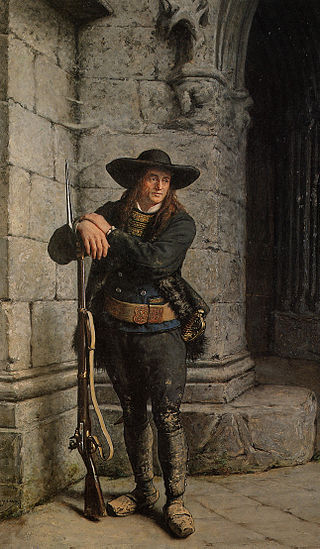Les Djinns is one of the most famous poems of French author Victor Hugo, published in 1829 in his collection Les Orientales .
Contents

Les Djinns is one of the most famous poems of French author Victor Hugo, published in 1829 in his collection Les Orientales .

"Les Djinns" is distinguished by its very original form, in "crescendo" and "decrescendo": the strophes have a different number of syllables, respectively 2, 3, 4, 5, 6, 7, 8, 10, 8, 7, 6, 5, 4, 3 and finally 2. This form resonates with the poem, [1] which is the account of the crash caused by the passage of a swarm of djinns around the narrator's house.
The epic and mystical force of this poem makes it one of the bravest pieces of the collection.
Les Djinns
Murs, ville,
Et port,
Asile
De mort,
Mer grise
Où brise
La brise,
Tout dort.
Dans la plaine
Naît un bruit.
C'est l'haleine
De la nuit.
Elle brame
Comme une âme
Qu'une flamme
Toujours suit!
La voix plus haute
Semble un grelot.
D'un nain qui saute
C'est le galop.
Il fuit, s'élance,
Puis en cadence
Sur un pied danse
Au bout d'un flot.
La rumeur approche.
L'écho la redit.
C'est comme la cloche
D'un couvent maudit ;
Comme un bruit de foule,
Qui tonne et qui roule,
Et tantôt s'écroule,
Et tantôt grandit,
Dieu ! la voix sépulcrale
Des Djinns !... Quel bruit ils font !
Fuyons sous la spirale
De l'escalier profond.
Déjà s'éteint ma lampe,
Et l'ombre de la rampe,
Qui le long du mur rampe,
Monte jusqu'au plafond.
C'est l'essaim des Djinns qui passe,
Et tourbillonne en sifflant!
Les ifs, que leur vol fracasse,
Craquent comme un pin brûlant.
Leur troupeau, lourd et rapide,
Volant dans l'espace vide,
Semble un nuage livide
Qui porte un éclair au flanc.
Ils sont tout près ! - Tenons fermée
Cette salle, où nous les narguons.
Quel bruit dehors ! Hideuse armée
De vampires et de dragons !
La poutre du toit descellée
Ploie ainsi qu'une herbe mouillée,
Et la vieille porte rouillée
Tremble, à déraciner ses gonds!
Cris de l'enfer! voix qui hurle et qui pleure!
L'horrible essaim, poussé par l'aquilon,
Sans doute, ô ciel ! s'abat sur ma demeure.
Le mur fléchit sous le noir bataillon.
La maison crie et chancelle penchée,
Et l'on dirait que, du sol arrachée,
Ainsi qu'il chasse une feuille séchée,
Le vent la roule avec leur tourbillon!
Prophète ! si ta main me sauve
De ces impurs démons des soirs,
J'irai prosterner mon front chauve
Devant tes sacrés encensoirs!
Fais que sur ces portes fidèles
Meure leur souffle d'étincelles,
Et qu'en vain l'ongle de leurs ailes
Grince et crie à ces vitraux noirs!
Ils sont passés ! - Leur cohorte
S'envole, et fuit, et leurs pieds
Cessent de battre ma porte
De leurs coups multipliés.
L'air est plein d'un bruit de chaînes,
Et dans les forêts prochaines
Frissonnent tous les grands chênes,
Sous leur vol de feu pliés!
De leurs ailes lointaines
Le battement décroît,
Si confus dans les plaines,
Si faible, que l'on croit
Ouïr la sauterelle
Crier d'une voix grêle,
Ou pétiller la grêle
Sur le plomb d'un vieux toit.
D'étranges syllabes
Nous viennent encor ;
Ainsi, des arabes
Quand sonne le cor,
Un chant sur la grève
Par instants s'élève,
Et l'enfant qui rêve
Fait des rêves d'or.
Les Djinns funèbres,
Fils du trépas,
Dans les ténèbres
Pressent leurs pas;
Leur essaim gronde:
Ainsi, profonde,
Murmure une onde
Qu'on ne voit pas.
Ce bruit vague
Qui s'endort,
C'est la vague
Sur le bord;
C'est la plainte,
Presque éteinte,
D'une sainte
Pour un mort.
On doute
La nuit...
J'écoute :
-Tout fuit,
Tout passe
L'espace
Efface
Le bruit.
This extremely famous poem was set to various adaptations or transpositions in other arts, such as Les Djinns (op. 12, 1875) [2] by Gabriel Fauré, for mixed choir, or the symphonic poem Les Djinns (FWV 45), composed by César Franck in 1884, as well as Louis Vierne's rendition of Les Djinns op. 35 [3] for voice and orchestra from 1912.

The Comédie-Française or Théâtre-Français is one of the few state theatres in France. Founded in 1680, it is the oldest active theatre company in the world. Established as a French state-controlled entity in 1995, it is the only state theatre in France to have its own permanent troupe of actors. The company's primary venue is the Salle Richelieu, which is a part of the Palais-Royal complex and located at 2, Rue de Richelieu on Place André-Malraux in the 1st arrondissement of Paris.
Clément Janequin was a French composer of the Renaissance. He was one of the most famous composers of popular chansons of the entire Renaissance, and along with Claudin de Sermisy, was hugely influential in the development of the Parisian chanson, especially the programmatic type. The wide spread of his fame was made possible by the concurrent development of music printing.

Chouan is a French nickname. It was used as a nom de guerre by the Chouan brothers, most notably Jean Cottereau, better known as Jean Chouan, who led a major revolt in Bas-Maine against the French Revolution. Participants in this revolt – and to some extent French anti-revolutionary activists in general – came to be known as Chouans, and the revolt itself came to be known as the Chouannerie.
La Panhypocrisiade, ou la comédie infernale du seizième siècle is a poem in sixteen cantos by Louis Jean Népomucène Lemercier, composed essentially under the French Consulate but not published until 1819.
Georges Politzer was a French philosopher and Marxist theoretician of Hungarian Jewish origin, affectionately referred to by some as the "red-headed philosopher". He was a native of Oradea, a city in present-day Romania. He was murdered in the Holocaust.

The Treaty of Huế or Protectorate Treaty was concluded on 6 June 1884 between France and Đại Nam. It restated the main tenets of the punitive Harmand Treaty of 25 August 1883, but softened some of the harsher provisions of this treaty. The treaty, which formed the basis for the protectorates of Annam and Tonkin, and for French colonial rule in Vietnam during the next seven decades, was negotiated by Jules Patenôtre, France's minister to China, and is often known as the Patenôtre Treaty. The treaty was signed on the Vietnamese side by Phạm Thận Duật and Tôn Thất Phan, representatives of the emperor Tự Đức’s court. The treaty marked the Nguyễn dynasty's second acceptance of French protectorate in central and northern Vietnam, but it was canceled by the Nguyễn dynasty on 11 March 1945.
L'Étoile de mer is a 1928 film directed by Man Ray and based on a short poem and longer scenario, both written by Robert Desnos. The film depicts a couple acting through scenes that are shot out of focus, and with Desnos himself as the second man in the final scene.

The Solvay Institute of Sociology [SIS; Institut de Sociologie Solvay] assumed its first "definitive form" on November 16, 1902, when its founder Ernest Solvay, a wealthy Belgian chemist, industrialist, and philanthropist, inaugurated the original edifice of SIS in Parc Léopold. Under the guidance of its first director, Emile Waxweiler, SIS expressed a "conception of a sociology open to all of the disciplines of the human sciences: ethnology, of course, but also economics [...] and psycho-physiology, contact with which was facilitated by the proximity of the Institute of Physiology". While SIS is now part of the Université Libre de Bruxelles and known more simply as that university's Institute of Sociology [Institut de Sociologie], the approach instigated by Solvay and Waxweiler still serves as methodological framework: a synergy between basic and applied research involving interdisciplinary studies firmly anchored in social life.

Colette Renard, born Colette Lucie Raget, was a French actress and singer. Renard is closely associated with the titular character from the musical Irma La Douce, a role she played for over a decade.
Danielle Bleitrach is a French sociologist and journalist. From the 1970s through the end of the century, she was CNRS researcher and lecturer at the Aix-Marseille University, focusing on the sociology of the working class and urbanization. From 1981 to 1996 she was a member of the Central Committee of the Communist Party of France, then the National Committee of the Party. She was also assistant editor-in-chief of the party weekly Révolution. She has contributed to La Pensée, Les Temps Modernes and Le Monde Diplomatique. In the 2000s and 2010s, after retiring from teaching, she co-authored texts on Cuba, Nazism and Ukraine.

Philippe Monneret is a French linguist. He is Professor of Linguistics at University of Burgundy since 2004 and at Paris-Sorbonne University since 2015. In 2003, he founded Les Cahiers de Linguistique Analogique and created the field of analogical linguistics. He is a member of the editorial board of «Romanica Olomucensia».

Correspondances is a song-cycle for soprano and orchestra written by the French composer Henri Dutilleux in 2002–2003.

Les Feuilles d'Automne is a collection of poems written by Victor Hugo, and published in 1831. It contains a multitude of poems, six of which are especially known as Soleils Couchants.

The Ramesses III prisoner tiles are a collection of Egyptian faience depicting prisoners of war, found in Ramesses III's palaces at Medinet Habu and Tell el-Yahudiyeh. Large numbers of faience tiles have been found in these areas by sebakh-diggers since 1903; the best known are those depicting foreign people or prisoners. Many were found in excavated rubbish heaps.
Gilbert Garcin was a French photographer.
Dealbanisation is a term used in historiographical and political discourse as the process of denationalisation of Albanians which was initiated by the Kingdom of Serbia after the annexation of Kosovo in 1912. The process continued to 1918 and was adopted by the Kingdom of Serbs, Croats and Slovenes against the Albanian populations of Kosovo between 1918 and 1938. The Kingdom of Serbs, Croats and Slovenes resisted the Kachak movement and used Serbo-Montenegrin colonisers in an attempt to "de-albanize" areas inhabited by Albanians. There is an integration process among Albanian immigrants in Greece that can be perhaps termed as 'de-albanisation'.

The Yehawmilk stele, de Clercq stele, or Byblos stele, also known as KAI 10 and CIS I 1, is a Phoenician inscription from c.450 BC found in Byblos at the end of Ernest Renan's Mission de Phénicie. Yehawmilk, king of Byblos, dedicated the stele to the city’s protective goddess Ba'alat Gebal.

The Neirab steles are two 8th-century BC steles with Aramaic inscriptions found in 1891 in Al-Nayrab near Aleppo, Syria. They are currently in the Louvre. They were discovered in 1891 and acquired by Charles Simon Clermont-Ganneau for the Louvre on behalf of the Commission of the Corpus Inscriptionum Semiticarum. The steles are made of black basalt, and the inscriptions note that they were funerary steles. The inscriptions are known as KAI 225 and KAI 226.

The Foucault gyroscope was a gyroscope created by French physicist Léon Foucault in 1852, conceived as a follow-up experiment to his pendulum in order to further demonstrate the Earth's rotation.
"Personal qualification salary" or "lifelong salary" refers to a form of remuneration proposed by Bernard Friot and the French popular education voluntary association Réseau Salariat. At its core is the distinction between work and employment. Funded using social security contributions, it would be the building block for a new mode of socioeconomic system.